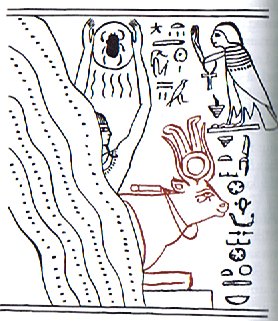Once again. The beginning of line Gb3 could have coincided with March 11, a time which by force of its distance from 0h was resembling December 21 (355):
In rongorongo times the heliacal stars at Gb3-1 were - according to my reconstruction ultimately based on the positions of Antares and Aldebaran on side a of the tablet - probably at *355, because the sequence of heliacal dates evidently continues on to side b:
There are no henua glyphs visible in line Gb3 (and neither are there any in line Ga2). Above the submerged earth birds and insects could hover - both named manu rere in contrast to the earth-bound moa. When these flying beasts had to rest, they could sit on the water.
From the heliacal positions of the stars in rongorongo times it was possible to extrapolate back in time to find out where the cardinal points of the Sun had been in ancient times, step by step and all the way down to the very beginning when the northern point of spring had been at the Hyades Gate (4 days after 0h):
Probably the star figures were produced by the astronomers to fit with the extrapolated cardinal positions of the Sun at the time of the Hyades Gate. The beginning of line Gb3 could then be coordinated with the stars which rose heliacally in early JANUARY, but which in rongongo times had advanced 64 days to early March. However, possibly could Sadalsud (β Aquarii) have been locked to the stars at the end of the year at the time of Bharani. Maybe the front side of the year had stations from the time of the Hyades Gate and the back side of the year stations from the time of Bharani.
The nakshatra date corresponding to January 4 was July 5 (186 = 369 - 183):
On Easter Island the month June (He Maro) was dry (maro) and the return of the Sun king in form of the bird of good luck could not come until in He Ana-Kena (July).
A reason for the nakshatra date July 5 (186) at Gb2-34 could have been the necessity to let 8 dark nights come before July 6 (187), before the 'morning light/life' returned (with morning star Venus as a model). Venus was absent from the night sky during 8 nights after she was last seen in the evening. And she was absent during 50 nights after she was last seen in the morning. 8 + 50 = 58 = 2 * 29. At the time of the Hyades Gate it ought to have been the heliacal return of Sirius which initiated such an 8-night long process of morning Sun return. Gb2-35 when read nakshatra wise: *171 (September 8) - 64 = *107 (July 6) and *107 - 8 = *91 (June 30, 181). In rongorongo times Sirius (101.2) was rising with the Sun in June 30. But in rongorongo times the stars would have advanced approximately 64 days further in the year compared to the time of the Hyades Gate, and 181 (June 30) + 64 = 245 (September 2, Gb2-29):
In rongorongo times Sirius rose with the Sun in day 245 (September 2) - 64 = 181 (June 30) and if Sirius was moving hand in hand with the Sun, then it would have been so also at the time of the Hyades Gate. Sirius was an exceptional star, extremely bright and unperturbed, it was thought, by the force of the precession: ... The Sothic cycle was based on what is referred to in technical jargon as 'the periodic return of the heliacal rising of Sirius', which is the first appearance of this star after a seasonal absence, rising at dawn just ahead of the sun in the eastern portion of the sky. In the case of Sirius the interval between one such rising and the next amounts to exactly 365.25 days - a mathematically harmonious figure, uncomplicated by further decimal points, which is just twelve minutes longer than the duration of the solar year ... ... It is the only star known to us with absolute certitude in the Egyptian records - its hieroglyph, a dog, often appearing on the monuments and temple walls throughout the Nile country. Its worship, chiefly in the north, perhaps, did not commence till about 3285 B.C., when its heliacal rising at the summer solstice marked Egypt's New Year and the beginning of the inundation ... At that early date, according to Lockyer, Sirius had replaced γ Draconis as an orientation point, especially at Thebes, and notably in the great temple of Queen Hatshepsu, known to-day as Al Dēr al Bahāri, the Arabs' translation of the modern Copt's Convent of the North. Here it was symbolized, under the title of Isis Hathor, by the form of a cow with disc and horns appearing from behind the western hills ...
|










